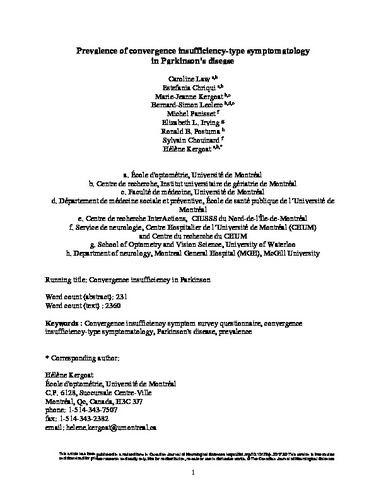| dc.contributor.author | Law, Caroline | |
| dc.contributor.author | Chriqui, Estefania | |
| dc.contributor.author | Kergoat, Marie-Jeanne | |
| dc.contributor.author | Leclerc, Bernard-Simon | |
| dc.contributor.author | Panisset, Michel | |
| dc.contributor.author | Irving, Elizabeth L. | |
| dc.contributor.author | Postuma, Ronald B. | |
| dc.contributor.author | Chouinard, Sylvain | |
| dc.contributor.author | Kergoat, Hélène | |
| dc.date.accessioned | 2019-12-11 19:54:56 (GMT) | |
| dc.date.available | 2019-12-11 19:54:56 (GMT) | |
| dc.date.issued | 2017-09 | |
| dc.identifier.uri | https://doi.org/10.1017/cjn.2017.39 | |
| dc.identifier.uri | http://hdl.handle.net/10012/15306 | |
| dc.description | This article has been published in a revised form in Canadian Journal of Neurological Sciences https://doi.org/10.1017/cjn.2017.39 This version is free to view and download for private research and study only. Not for re-distribution, re-sale or use in derivative works. © The Canadian Journal of Neurological Sciences | en |
| dc.description.abstract | Background: Individuals with Parkinson’s disease (PD) often present with visual symptoms (e.g., difficulty in reading, double vision) that can also be found in convergence insufficiency (CI). Our objective was to estimate the prevalence of CI-type visual symptomatology in individuals with PD, in comparison with controls. Methods: Participants ≥50 years with (n=300) and without (n=300) PD were recruited. They were administered the Convergence Insufficiency Symptom Survey (CISS–15) over the phone. A score of ≥21 on the CISS–15, considered positive for CI-type symptomatology, served as the cutoff. Data from individuals (n=87 with, n=94 without PD) who were approached but who reported having a known oculovisual condition were analysed separately. Student’s t test and chi-square at the 0.05 level were employed for statistical significance. Results: A total of 29.3% of participants with versus 7.3% without PD presented with a score of ≥21 on the CISS–15 (p=0.001). Of the participants having a known oculovisual condition, 39.1% with versus 19.1% without PD presented with a score of ≥21 on the CISS–15 (p=0.01). Conclusions: The prevalence of CI-type visual symptoms is higher in individuals with versus without PD whether or not they have a coexisting oculovisual condition. These results suggest that PD per se places individuals with the disease at greater risk of visual symptomatology. These results further underline the importance of providing regular eye exams for individuals with PD. | en |
| dc.description.sponsorship | This work was supported by the Comité aviseur pour la recherche clinique (CAREC) at the Institut universitaire de gériatrie de Montréal (IUGM), the Canadian Institutes of Health Research (CIHR: MOP-123462) and the Canadian Optometric Education Trust Fund (COETF). | en |
| dc.language.iso | en | en |
| dc.publisher | Cambridge University Press | en |
| dc.subject | convergence insufficiency symptom survey questionnaire | en |
| dc.subject | convergence insufficiency-type symptomatology | en |
| dc.subject | Parkinson's disease | en |
| dc.subject | prevalence | en |
| dc.title | Prevalence of Convergence Insufficiency-Type Symptomatology in Parkinson’s Disease | en |
| dc.type | Article | en |
| dcterms.bibliographicCitation | Law, C., Chriqui, E., Kergoat, M., Leclerc, B., Panisset, M., Irving, E., . . . Kergoat, H. (2017). Prevalence of Convergence Insufficiency-Type Symptomatology in Parkinson’s Disease. Canadian Journal of Neurological Sciences / Journal Canadien Des Sciences Neurologiques, 44(5), 562-566. doi:10.1017/cjn.2017.39 | en |
| uws.contributor.affiliation1 | Faculty of Science | en |
| uws.contributor.affiliation2 | School of Optometry and Vision Science | en |
| uws.typeOfResource | Text | en |
| uws.peerReviewStatus | Reviewed | en |
| uws.scholarLevel | Faculty | en |

